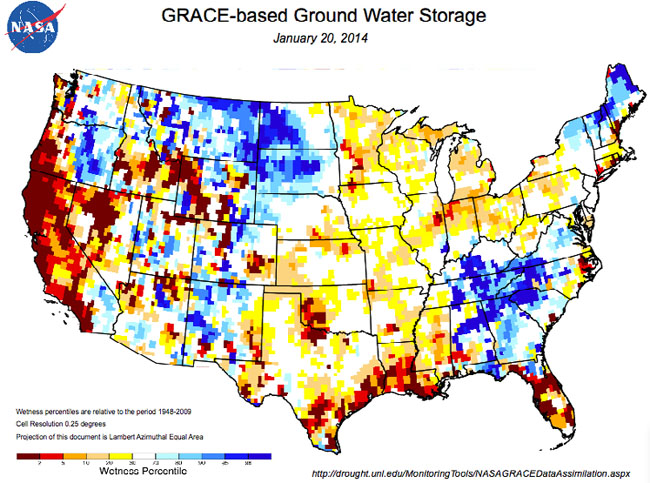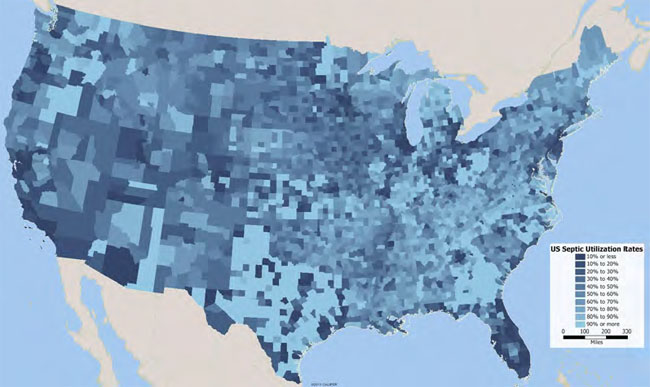Decentralized Wastewater Treatment Shines As Aquifer Recharge Solution

By Jessica L. Kautz, project engineer, Infiltrator Water Technologies
Decentralized wastewater treatment systems have come a long way. Learn how new advancements have broadened their potential and may provide relief to fast-depleting groundwater resources.
Potable water sources are being exploited worldwide; water tables are dropping at drastic rates, causing wells to run dry, saltwater to intrude inland and leaving an increasing number of people without reliable sources of life-sustaining water. As populations continue to grow and shift, it is imperative for all aspects of the water cycle to be optimized for sustainability.
Wastewater treatment creates a large impact on the water cycle, as large volumes of water are processed on a daily basis. The foremost goal of wastewater treatment has always been and continues to be the protection of public health. However, as the industry grows and the complexities of the challenges expand, it is important to consider that the method and level of treatment greatly impact environmental health and sustainability, as well as our potable water supplies. It is our responsibility as engineers, designers, and citizens to protect both public and environmental health.
Models Of Wastewater Treatment
Two general models are used in wastewater treatment — centralized and decentralized wastewater treatment. Centralized wastewater treatment involves the collection of wastewater from a large area to one centralized location, where it is most commonly treated and released into local surface waters. Conversely, decentralized wastewater treatment provides treatment and disposal either directly on site or at a nearby location. Both methods can be designed to provide equivalent levels of treatment and protection of public health.
However, centralized and decentralized wastewater treatment systems vary greatly in regard to their impacts on environmental health and potable water supplies. Centralized treated effluent is usually released into flowing waterbodies (such as rivers or oceans); malfunctions in system performance therefore pose a significant risk to public health as they can flood surface waters with contaminants or hazardous chemicals. In addition, the clean water discharged from the facility is largely carried away from its original location before it filtrates into the soil, evaporates, or is removed for a downstream potable water supply. Discharge thus provides limited groundwater recharge of the billions of gallons of treated effluent released daily. Centralized wastewater infrastructure also adds to groundwater depletion, as leaking pipes can cause groundwater to infiltrate into the pipes and be carried to the centralized facility.
Decentralized systems, on the other hand, treat and filter effluent through the soil directly into the local aquifers. Once filtered through the natural soil into the aquifers, the clean water travels to surface waters or wells or estuaries, where it can be utilized by humans and natural ecosystems. In this way, decentralized wastewater treatment systems provide the most passive and environmentally sound form of aquifer recharge and wastewater recycling.
Aquifer Recharge Using Decentralized Wastewater Treatment
Aquifer recharge is a growing method of water table stabilization and water supply in the U.S. The U.S. EPA defines aquifer recharge as, “the enhancement of natural groundwater supplies using man-made conveyances such as infiltration basins or injection wells.” As currently defined by the EPA, aquifer recharge systems are typically used in areas with limited ground or surface water availability.
Figure 1. Groundwater depletion in the continental U.S.

However, when adequately designed and installed, a decentralized wastewater system can process large amounts of wastewater through the underlying soils, making it one of the most passive, sustainable forms of aquifer recharge.
Rather than partially to fully treating wastewater effluent, then discharging it to a surface pond or injection well before recharging the aquifer, decentralized systems provide both wastewater treatment and groundwater recharge in one step.
Figures 1 and 2 show the groundwater deficits in the United States and the decentralized utilization rates for each state, respectively. In general, areas in dark red on the groundwater storage map correlate with areas of light decentralized utilization, as well as the opposite; a general correlation can therefore be made between low septic utilization rates and groundwater depletion. While other factors greatly impact groundwater depletion (e.g., precipitation, urbanization, and agricultural practices), the figures can be interpreted to show that decentralized wastewater treatment has an impact on groundwater storage.
Applicability Of Decentralized Wastewater Treatment
As technology continues to advance, an increasing number of sites have become viable candidates for decentralized systems. For example, designing a small-scale, advanced treatment train prior to dispersal of the effluent into the native soil can decrease both the absorption area and depth to limiting layers that are required for adequate treatment. This has allowed decentralized systems to be placed in areas previously inaccessible, in turn increasing the volume of groundwater recharge associated with decentralized systems.
While traditionally thought of as a low-flow wastewater treatment solution, decentralized systems can be designed to treat any volume of wastewater. Community decentralized systems are being designed and used increasingly where lot sizes or site conditions limit the use of individual on-site wastewater treatment systems. Large systems can also be developed for large flow commercial and industrial sites, decreasing the hydraulic and nutrient stress placed on centralized wastewater treatment plants.
Decentralized systems are conventionally managed by individual homeowners, who can be undereducated or unable to adequately maintain their systems; this is a main reason why the decentralized model is often immediately dismissed. This is also changing. Centrally managed decentralized wastewater treatment systems, such as publicly and privately owned community systems, are being staffed with trained and educated personnel in the same manner as centralized systems.
Figure 2. Decentralized wastewater treatment utilization in the continental U.S.

Case Study: Loudoun County, Virginia
Loudoun County, VA has adopted a combined approach to wastewater treatment, utilizing both centralized and community decentralized treatment facilities. Community decentralized treatment facilities are publicly owned and maintained by Loudoun Water in the same manner as the county’s centralized treatment plant. As the county continues to grow, developers integrate new community decentralized facilities then transfer ownership and operation to Loudoun Water. All homes connected to the community systems pay taxes and fees matching those paid by homes connected to the centralized system, which allows sustainable operation and maintenance. One of the subdivisions serviced by decentralized wastewater treatment is Elysian Heights. This wastewater treatment system was designed to serve a 324-home subdivision and 5 acres of commercial land. For more information on the Loudoun Water decentralized systems, visit www.loudounwater.org.
Conclusion
Decentralized wastewater treatment can provide equal or better protection of public health while outshining centralized wastewater treatment in environmental protection. Where individual lots are not suitable for decentralized treatment on site, community decentralized systems can provide sustainable and responsible wastewater treatment. Decentralized systems provide a low-cost, environmentally friendly, passive form of both wastewater treatment and aquifer recharge, combatting the declining groundwater table and protecting public health.
About The Author
 Jessica L. Kautz, EIT (jkautz@infiltratorwater.com) recently joined Infiltrator Water Technologies as a project engineer after graduating with her M.S. in Civil and Environmental Engineering from the Colorado School of Mines and her B.S. in Civil Engineering with an Environmental Concentration from the University of Hartford. Kautz has spent her time at Infiltrator working closely with both the Research & Development and Science & Government Affairs departments to research, develop, and gain approval for new products.
Jessica L. Kautz, EIT (jkautz@infiltratorwater.com) recently joined Infiltrator Water Technologies as a project engineer after graduating with her M.S. in Civil and Environmental Engineering from the Colorado School of Mines and her B.S. in Civil Engineering with an Environmental Concentration from the University of Hartford. Kautz has spent her time at Infiltrator working closely with both the Research & Development and Science & Government Affairs departments to research, develop, and gain approval for new products.
